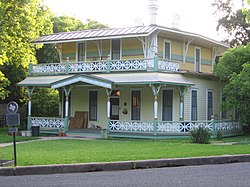
The Fan is a district of Richmond, Virginia, so named because of the "fan" shape of the array of streets that extend west from Belvidere Street, on the eastern edge of Monroe Park, westward to Arthur Ashe Boulevard. However, the streets rapidly resemble a grid after they go through what is now Virginia Commonwealth University. The Fan is one of the easterly points of the city's West End section, and is bordered to the north by Broad Street and to the south by VA 195, although the Fan District Association considers the southern border to be the properties abutting the south side of Main Street. The western side is sometimes called the Upper Fan and the eastern side the Lower Fan, though confusingly the Uptown district is located near VCU in the Lower Fan. Many cafes and locally owned restaurants are located here, as well as historic Monument Avenue, a boulevard formerly featuring statuary of the Civil War's Confederate president and generals. The only current statue is a more modern one of tennis icon Arthur Ashe. Development of the Fan district was strongly influenced by the City Beautiful movement of the late 19th century.

Hyde Park is a neighborhood and historic district in Austin, Texas. Located in Central Austin, Hyde Park is defined by 38th Street to the south, 45th Street to the north, Duval Street to the east, and Guadalupe Street to the west. It is situated just north of the University of Texas and borders the neighborhoods of Hancock and North Loop.

The Swedish Hill Historic District is a former Swedish enclave that is now a residential area of downtown Austin, Texas. It is often referred to as "Swede Hill."
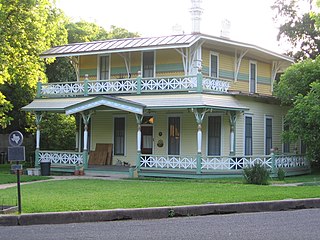
The Col. Monroe M. Shipe House is a historic two-story home in the Hyde Park historic district in Austin, Texas, United States. The building was completed by Monroe M. Shipe, founder of Hyde Park, in 1892. It uses an eclectic combination of styles, including a Stick style form, Queen Anne decorations, and a flat concrete roof.

The Hildreth–Flanagan–Heierman House is a historic home in the Hyde Park historic district in Austin, Texas. It is also a part of the Shadow Lawn Historic District, a subdivision of the Hyde Park neighborhood designated by Hyde Park founder Monroe M. Shipe.

The Frank M. and Annie G. Covert House is a historic home in the Hyde Park Historic District in Austin, Texas, United States. It is also a part of the Shadow Lawn Historic District, a subdivision within the Hyde Park neighborhood established by Hyde Park founder Monroe M. Shipe.
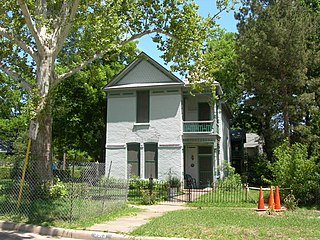
The Page–Gilbert House is a historic home in the Hyde Park Historic District in Austin, Texas, United States. It is also a part of the Shadow Lawn Historic District, a subdivision within the Hyde Park neighborhood established by Hyde Park founder Monroe M. Shipe.

The Smith–Marcuse–Lowry House is an historic home in the Hyde Park Historic District in Austin, Texas. It is also a part of the Shadow Lawn Historic District, a subdivision within the Hyde Park neighborhood established by Hyde Park founder Monroe M. Shipe.

The Oliphant–Walker House is a historic home in the Hyde Park Historic District in Austin, Texas. It is also a part of the Shadow Lawn Historic District, a subdivision within the Hyde Park neighborhood established by Hyde Park founder Monroe M. Shipe.

The Peter and Clotilde Shipe Mansbendel House is an historic home in the Hyde Park Historic District in Austin, Texas, United States. It is also a part of the Shadow Lawn Historic District, a subdivision within the Hyde Park neighborhood established by Hyde Park founder Monroe M. Shipe.

The Kenwood Historic District is a district located in St. Petersburg, Florida U.S.A. It was designated on August 4, 2003, and is located immediately west of downtown, bounded by 9th Avenue North, 1st Avenue North, 19th Street North and 34th Street North. It contains 2,203 historic buildings. The Grand Central adjoins the district at its southern boundary.

The F. Q. Story Neighborhood Historic District is located in central Phoenix, Arizona, United States. The neighborhood runs from McDowell Road south to Roosevelt Street and from Seventh Avenue west to Grand Avenue. The neighborhood as well as many of the individual houses are listed on the National Register of Historic Places.

The Drake Park Neighborhood Historic District is located adjacent to Drake Park near the historic downtown area in Bend, Oregon, United States. Because of the unique and varied architecture in the Drake Park neighborhood and its close association with the early development of the city of Bend, the area was listed on the National Register of Historic Places in 2005.

The Medbury's–Grove Lawn Subdivisions Historic District is a residential historic district located in Highland Park, Michigan. It runs along three east–west streets: Eason Street, Moss Street, and Puritan Street, from Hamilton Avenue on the west to Woodward Avenue on the east. The district was listed on the National Register of Historic Places in 1988.
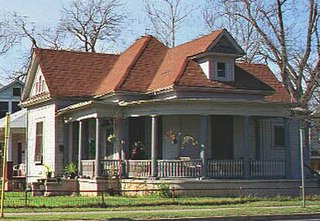
The Willow–Spence Streets Historic District is a neighborhood that lies east of downtown Austin, Texas. Its houses, churches, and commercial buildings were built in the early twentieth century. It is bounded roughly by Interstate 35 to the west, East César Chávez Street to the north, and Spence Street to the south. It extends a few houses east of San Marcos Street along Willow and Canterbury Streets. It thus includes portions of Willow, Spence, Canterbury, San Marcos, and Waller Streets. It was added to the National Register of Historic Places in 1985.
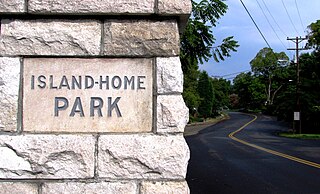
Island Home Park is a neighborhood in Knoxville, Tennessee, United States, located in the southeastern part of the city along the Tennessee River. Developed as a streetcar suburb in the early 1900s, the neighborhood retains most of its original houses and streetscapes, and is home to the city's largest concentration of Bungalow-style houses. In 1994, several dozen houses in Island Home Park were added to the National Register of Historic Places as the Island Home Park Historic District.
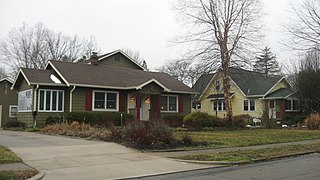
The Homecroft Historic District is a national historic district bounded roughly by Madison Avenue, Southview Drive, Orinoco Avenue, and Banta Road in Homecroft, Perry Township, Marion County, Indiana. It was listed on the National Register of Historic Places in 1996.
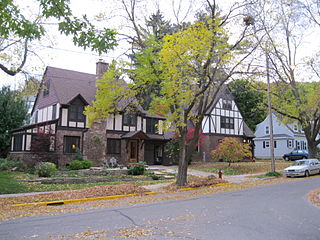
West Lawn Heights Historic District is a residential historic district on the near west side of Madison, Wisconsin. The district encompasses 403 buildings, nearly all of which are houses, spread over roughly 23 city blocks. It was added to the National Register of Historic Places in 1998.

Colonel Monroe Martin Shipe, also called M. M. Shipe, was an American real estate developer who developed Hyde Park, an early streetcar suburb in Austin, Texas. He also founded the Austin Electric Railway Company, a streetcar network that initially served Hyde Park but expanded to become the public transit network for the city of Austin and, eventually, the direct predecessor of Austin's current transit agency, Capital Metropolitan Transportation Authority.

The Baker Center, previously the Baker School, Baker Junior High School, and W. R. Robbins High School, is a historic building in the Hyde Park neighborhood of Austin, Texas. It has been, in sequential order, an elementary school, a middle school, an alternative high school, and an administrative building for Austin ISD. In 2018, the Baker Center was bought by Tim and Karrie League founders of Alamo Drafthouse, and now serves as their corporate headquarters.
